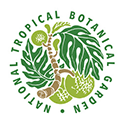Herbarium Sheet Detail
NTBG Plant Name:
Delissea kauaiensis
Collector Name:
K. R. Wood
Collection Date:
October 2, 2004
Determiner:
Nom. Rev. K. R. Wood (PTBG) April 2012
Observers:
David Viets, Paul Massey
Island Group:
HAWAIIAN ISLANDS
Locality:
Mahanaloa, just east of Pteralyxia exclosure.
Plant Description:
Tree #2, 3.5 m tall, single head, stems gray or tan-brown, corolla lobes green maturing with purple tinge, with purple fruit, four mature and two juvenile individuals just east of the Pteralyxia exclosure and a single individual just west of the Euphorbia exclosure in central region of Plot # 10 at around 2100 ft.
Habitat:
Diospyros mixed mesic forest.
Associated Species:
With Metrosideros, Pisonia, Pteralyxia kauaiensis, Kokia kauaiensis, Myrsine lanaiensis, Nestegis sandwicensis, Diospyros hillebrandii, Diospyros sandwicensis, and Melicope ovata. Ground covers include Carex meyenii, Alyxia oliviformis, Doodia kunthiana, and Dryopteris unidentata.
Comments:
Seeds removed for viability study by D. Wolkis, K. Jones, N. Ronsted Nov 2019 Delissea niihauensis subsp. kauaiensis
Research Dates.
Poopooiki: 9 Apr 2000; 3 Aug 2000;
Mahanaloa: 15 Jun 2001
Kuia: 15 Jun 2001
In Situ Status. Around ten trees range between Mahanaloa and Kuia Valleys, Kaua`i.
Poopooiki Population. The two plants of Delissea niihauensis subsp. kauaiensis that were located in Poopooiki valley during a 1996 survey of that region by NTBG staff biologists have not been relocated. These plants were located around 2300 ft elev on the north facing slopes of the Poopooiki mesic drainage. They were growing in brown granular soil with leaf litter on the steep banks that are characteristic just above the gulch bottom. They occurred in a Metrosideros-Acacia montane mesic forest with regions co-dominated by Alphitonia ponderosa (Rhamnaceae). Associated canopy trees include Euphorbia haeleeleana (Euphorbiaceae—44 individuals observed); Psychotria hobdyi (Rubiaceae—14 trees observed); Pritchardia minor (Arecaceae—two individuals in the immediate area); Remya kauaiensis (Asteraceae—five plants); Isodendrion laurifolium (Violaceae—one plant was seen); Peucedanum sandwicense (Apiaceae—growing in a small patch); and Chamaesyce halemanui (Euphorbiaceae—three individuals growing close together). Additional associates include: Pouteria sandwicensis (Sapotaceae), Bobea brevipes (Rubiaceae), Melicope ovata, M. barbigera, & M. anisata (Rutaceae), Psychotria greenwelliae, P. mariniana (Rubiaceae), Xylosma hawaiiense (Flacourtiaceae), Pittosporum kauaiense (Pittosporaceae) Cryptocarya mannii (Lauraceae), Tetraplasandra kavaiensis (Araliaceae), and Pleomele aurea (Agavaceae). Understory species include Styphelia tameiameiae (Epacridaceae), Dodonaea viscosa (Sapindaceae), and Scaevola procera (Goodeniaceae). Ground cover included Panicum nephelophilum (Poaceae), Carex meyenii & Gahnia beecheyi (Cyperaceae), Diplazium sandwichianum (Doodia kunthiana & Dryopteris unidentata, (Dryopteridaceae), Lepisorus thunbergianus (Polypodiaceae). The main threats to this population include habitat degradation by feral deer and pigs, the potential of fire during prolonged droughts, and the loss of reproductive vigor as the result of limited numbers of existing individuals. Localized weed species in their order of dominance include: Lantana camara (Verbenaceae), Psidium cattleianum (Myrtaceae), Erigeron karvinskianus (Asteraceae),Rubus rosifolius & Rubus argutus (Rosaceae), Passiflora ligularis (Passifloraceae), and Setaria parviflora (Poaceae),
Mahanaloa Population. NTBG researchers are aware of around four individuals of D. niihauensis kauaiensis in Mahanaloa Valley. This population has been monitored for many years, yet plants have not been observed in flower or fruit. The Mahanaloa population has four individuals just east of the Pteralyxia exclosure and a single individual just west of the Euphorbia exclosure in central region of Plot # 10 at around 2100 ft. The Mahanaloa trees range between 3-4 m tall and are multi-branching. These plants grow in brown-black granular soil with leaf litter and have a north aspect along moderate to steep slopes of forested banks. The botanical community constitutes one of the few remaining diverse mesic forests on Kaua`i with associated species such as Metrosideros, Pisonia, Pteralyxia kauaiensis, Kokia kauaiensis, Myrsine lanaiensis, Nestegis sandwicensis, Diospyros hillebrandii, Diospyros sandwicensis, and Melicope ovata. Ground covers include Carex meyenii, Alyxia oliviformis, Doodia kunthiana, and Dryopteris unidentata. The main threats to this population include habitat degradation by feral deer, pigs, rats, leaf hopper, competition with non-native plant taxa such as Lantana camara, Psidium guajava, and Rubus rosifolius and the loss of reproductive vigor as the result of limited numbers of existing individuals.
Kuia Population. There are three plants of Delissea niihauensis subsp kauaiensis in the State Department of Forestry and Wildlife exclosure, which occurs on north facing forested slopes of Kuia valley just above the confluence of Mahanaloa and Kuia drainage at 2000 ft elevation. These plants grow in rich brown-black soil with leaf litter on a relatively steep (35°) slope in closed canopy forest around mid-slope. The botanical community is dominated by Metrosideros and includes associated species such as Diospyros sandwicensis, Dodonaea viscosa, Psychotria mariniana, Psychotria greenwelliae, and Acacia koa. The main threats to this population include habitat degradation by feral pigs, deer, and rats, competition with non-native plant taxa such as Psidium cattleianum, Setaria gracilis, Kalanchoe pinnata, Grevillea robusta, and Lantana camara, and the loss of reproductive vigor as the result of limited numbers of existing individuals.
Ex Situ Status
Ex situ collections do not exist of D. niihauensis subsp. kauaiensis at this time in seed storage, nursery, tissue culture, or planted out.
*Note: annotated as D. niihauensis subsp kauaiensis by Lammers (see K. R. Wood 0420 collected in 1990).
Date of Record Creation:
January 20, 2014
Date of Last Update:
March 23, 2023
<< Return to Search Results | New Search
